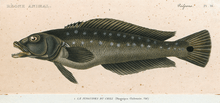Microcotyle moyanoi
Microcotyle moyanoi is a species of monogenean, parasitic on the gills of a marine fish. It belongs to the family Microcotylidae.[1]
| Microcotyle moyanoi | |
|---|---|
| Scientific classification | |
| Kingdom: | Animalia |
| Phylum: | Platyhelminthes |
| Class: | Monogenea |
| Order: | Mazocraeidea |
| Family: | Microcotylidae |
| Genus: | Microcotyle |
| Species: | M. moyanoi |
| Binomial name | |
| Microcotyle moyanoi | |
| Synonyms | |
| |
Systematics
Microcotyle moyanoi was first described and illustrated based on specimens from the gills off the Chilean sandperch Pinguipes chilensis (Pinguipedidae ) off Chile.[1] In the original description, this species was placed in Paramicrocotyle,[1] a genus erected for P. atriobursata and P. tampicensis [3] and distinguished from Microcotyle by the following features: structure of the haptor, structure and shape of the genital atrium and the presence of two vitellovaginal pouches. 16 species previously belonging to the genus Microcotyle were placed in this newly erected genus .[3][2] Later, Mamaev (1986) synonymised Paramicrocotyle with Microcotyle,[4] and Paramicrocotyle was considered taxon inquirendum.[5] Mamaev (1986) did not change the generic status of P. danielcarrioni, described simultaneously to his study.[2]
Based on morphological similarities between the genus: Microcotyle and Paramicrocotyle, Bouguerche et al., followed Mamaev (1986) and considered Paramicrocotyle a junior synonym of Microcotyle as their molecular analyses included a member of Paramicrocotyle placed amongst other species of Microcotyle without having a distinct branch. Paramicrocotyle moyanoi was transferred to the genus Microcotyle.[2]
Description
Microcotyle moyanoi has the general morphology of all species of Microcotyle, with a symmetrical body, comprising an anterior part which contains most organs and a posterior part called the haptor. The haptor is symmetrical, and bears clamps, arranged as two rows, one on each side. The clamps of the haptor attach the animal to the gill of the fish. There are also two buccal suckers at the anterior extremity. The digestive organs include an anterior, terminal mouth, a pharynx, an oesophagus and a posterior intestine with two lateral branches provided with numerous secondary branches. Each adult contains male and female reproductive organs. The reproductive organs include an anterior genital atrium, armed with numerous very spines, a medio-dorsal vagina, a single ovary and a number of testes which are posterior to the ovary.[1]
Hosts and localities

The type-host is the Chilean sandperch Pinguipes chilensis (Pinguipedidae) [6] referred to as Mugiloides chilensis in the original description.[1] It was also reported on Bovichtus chilensis (Bovichtidae).[7] Microcotyle moyanoi was first described from fishes caught off Chile.[1] It was reported again off the type locality.[7][8]
References
- Villalba, C., & Fernàndez, J. (1986). Dos nuevas especies de tremàtodos paràsitos de peces marinos en Chile. Parasitologia al Dia, 10, 45–51.
- Bouguerche, Chahinez; Gey, Delphine; Justine, Jean-Lou; Tazerouti, Fadila (2019). "Microcotyle visa n. sp. (Monogenea: Microcotylidae), a gill parasite of Pagrus caeruleostictus (Valenciennes) (Teleostei: Sparidae) off the Algerian coast, Western Mediterranean". Systematic Parasitology. doi:10.1007/s11230-019-09842-2. ISSN 0165-5752. (subscription required)
- Caballero y Caballero, E., & Bravo-Hollis, M. (1972). Monogenea (van Beneden, 1858) Carus, 1863 de peces marinos del litoral Mexicano del Golfo de Mexico y del Mar Caribe.V. Revista de Biología Tropical, 20, 151-165. PDF

- Mamaev, Y. L. (1986). The taxonomical composition of the family Microcotylidae Taschenberg, 1879 (Monogenea). Folia Parasitologica, 33, 199-206. PDF

- Mendoza-Franco, Edgar F.; Rosado Tun, Mariela del Carmen; Duarte Anchevida, Allan de Jesús; del Rio Rodríguez, Rodolfo E. (2018). "Morphological and molecular (28S rRNA) data of monogeneans (Platyhelminthes) infecting the gill lamellae of marine fishes in the Campeche Bank, southwest Gulf of Mexico". ZooKeys. 783: 125–161. doi:10.3897/zookeys.783.26218. ISSN 1313-2970. PMC 6160863.
- Muñoz, Gabriela; Olmos, Viviana (2007). "Revisión bibliográfica de especies ectoparásitas y hospedadoras de sistemas acuáticos de Chile". Revista de biología marina y oceanografía. 42 (2). doi:10.4067/S0718-19572007000200001. ISSN 0718-1957.
- Muñoz G, V Valdebenito & M George-Nascimento. 2002. La dieta y la fauna de parásitos metazoos del torito Bovichthys chilensis Regan 1914 (Pisces: Bovichthydae) en la costa de Chile centro-sur: variaciones geográficas y ontogenéticas. Revista Chilena de Historia Natural 75: 661-671.
- Riffo R & M Nuñez. 2000. La fauna de parásitos metazoos del rollizo Mugiloides chilensis (Pisces: Mugiloididae): la importancia de las relaciones ecológicas del hospedador. Medio Ambiente 13: 89-96.